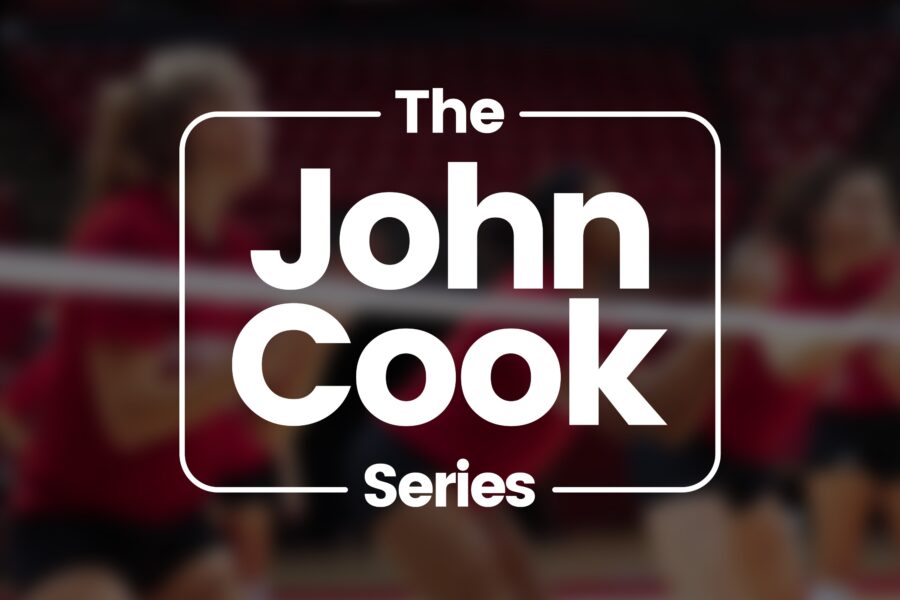John Cook Explains How to Get on Recruiting Radars

In the final blog of our three-part series, Nebraska’s head coach digs deeper into recruiting.
Video opens the door to recruiting
As a five-time national championship program, Nebraska is highly attractive to high school players. They receive hundreds, if not thousands, of emails from prospective athletes. How do Cook and his staff filter through these players to find who they need? For a top-tier program like Nebraska, highlight videos are used as a quick screening tool.
“We get tons of emails a day with video on it now. Most of them, we use it just to say, ‘OK, can she play here, is this someone we want to watch live or not?’” Cook said. “So we use that to say yes or no because we are recruiting such a select group of people.”
Although schools like Nebraska typically use highlight videos to initially determine which players to recruit in person, Cook said this isn’t the case for most programs. For smaller Division I and Division II programs, video is one of the most crucial parts of their recruiting process.
“I think for those coaches, video becomes super valuable because they don’t have the time or budget to go recruit all those players,” Cook said.
Many schools have fewer resources and a smaller budget, so video can be one of the only ways for coaches to recruit. These schools may require more work on the players’ part so remind your players that sending an email is just the first step.
“Remember these coaches are getting lots of videos, so follow it up with a call, whether it is from the coach or a player and just say hey I’m really interested, here’s my profile, I’d like to visit.” Cook said.
3 qualities of an impressive highlight
Your players need to create highlights that will set them apart from hundreds of their peers. Cook shared what he looks for when watching a player’s highlights—use his input to help your players catch the eyes of coaches like him.
1. Skill
“How do they move? What are they exceptional at? If they’re a setter, how well can they set the ball and can they do other things as well? If they are a middle, they basically have to jump, hit, block. Liberos, we don’t care if they can jump, so we’re looking at how well they can move and what kind of touch they have on a ball.”
2. Body Language
“Are they positive teammates? Are they bringing energy to the court? Are they giving to their teammates? You can pick that up really quickly [on video]. Just watch a couple plays or watch when a mistake happens and see how they respond. That’s something hard to coach to people, so we want to make sure we have people who are positive givers to their team and their teammates.”
3. The BIG Moments
“What happens at crunch time or the defining moments of a game. Do they want the ball? Do they make aggressive plays? Do they make an easy serve or do they really go for it? So who is really trying to win that point opposed to who might be afraid of just not messing up.”
If Cook looks for these aspects, you can bet other college coaches do too. Encourage your players to focus on these areas to be sure they leave a lasting impression.
What to tell parents about recruiting
Parents typically play a big role in their child’s recruiting journey. But, in a process full of rules and strategies, it’s often hard for them to know the best way to prepare their child for success in college. As a parent of a former Division I player, Cook has a unique perspective on recruiting. His advice for parents? Gain an accurate understanding of the appropriate next level for their child.
“Parents think their kids are either better than they are or maybe not as good as they are,” Cook said. “So first, get a good coach, a high school coach or a club coach or maybe go to camp and have the college coaches evaluate what level can your daughter play at.”
Your players already have you, so it’s your job to help them distinguish what level they’re capable of playing at. Once they and their parents have accepted that level, the next step is finding the best suited conference and school. Don’t forget to add their academic level to the equation. Once these decisions are made, encourage your players to begin reaching out to coaches.
“It’s like anything, if you want a job, you got to go apply for it.”
If it’s recruiting advice you want, Cook is the one to listen to. Want to hear more insights from him? Check out The Past, Present and Future of Volleyball, According to John Cook and John Cook: Why Video Matters in Volleyball.

